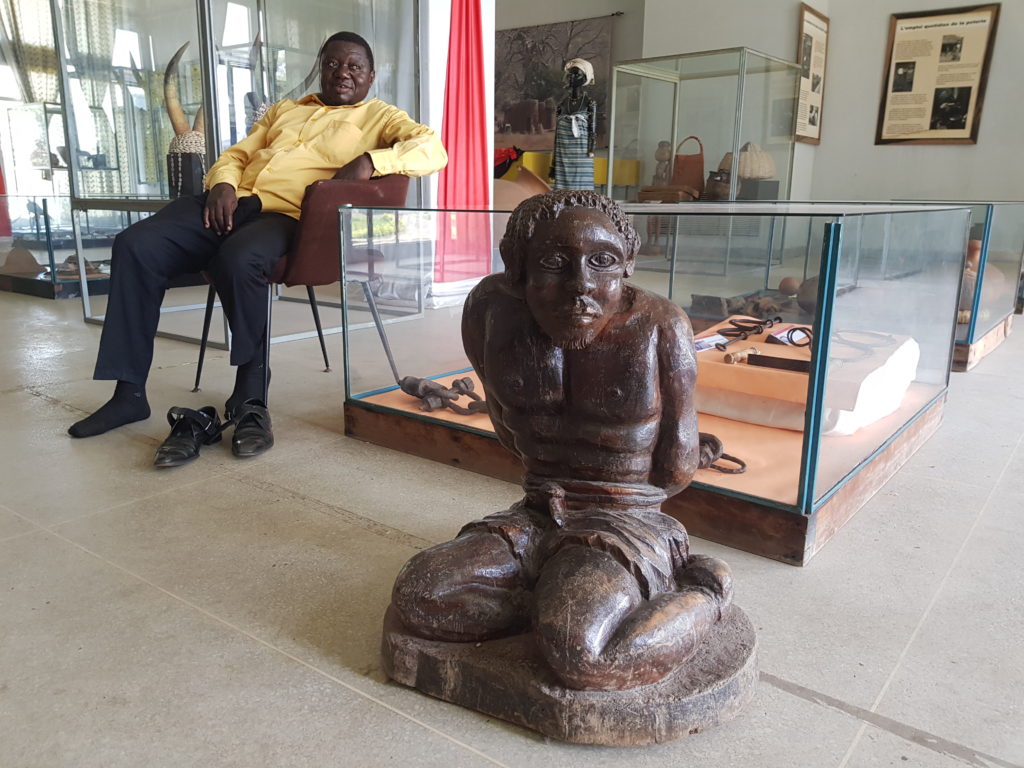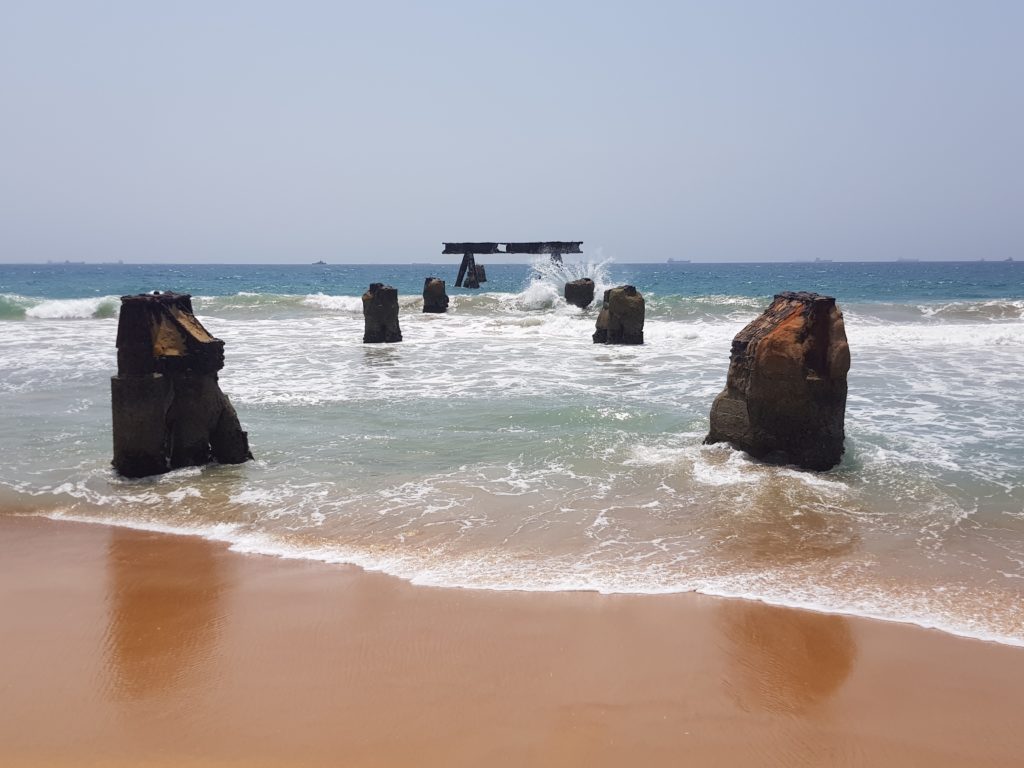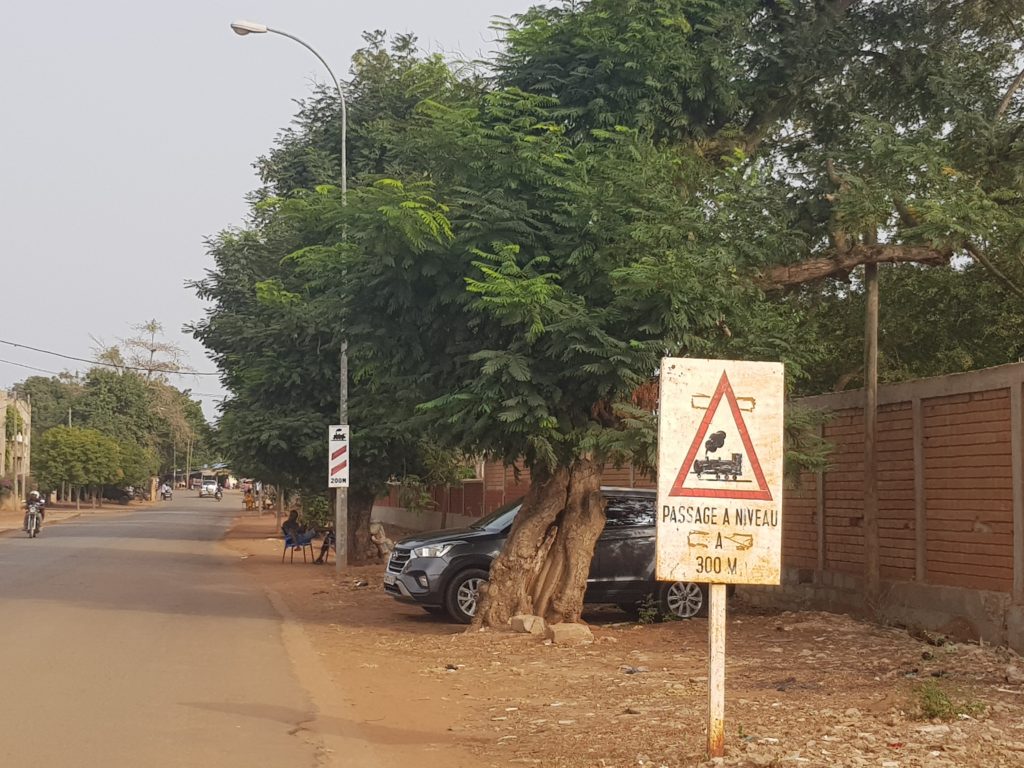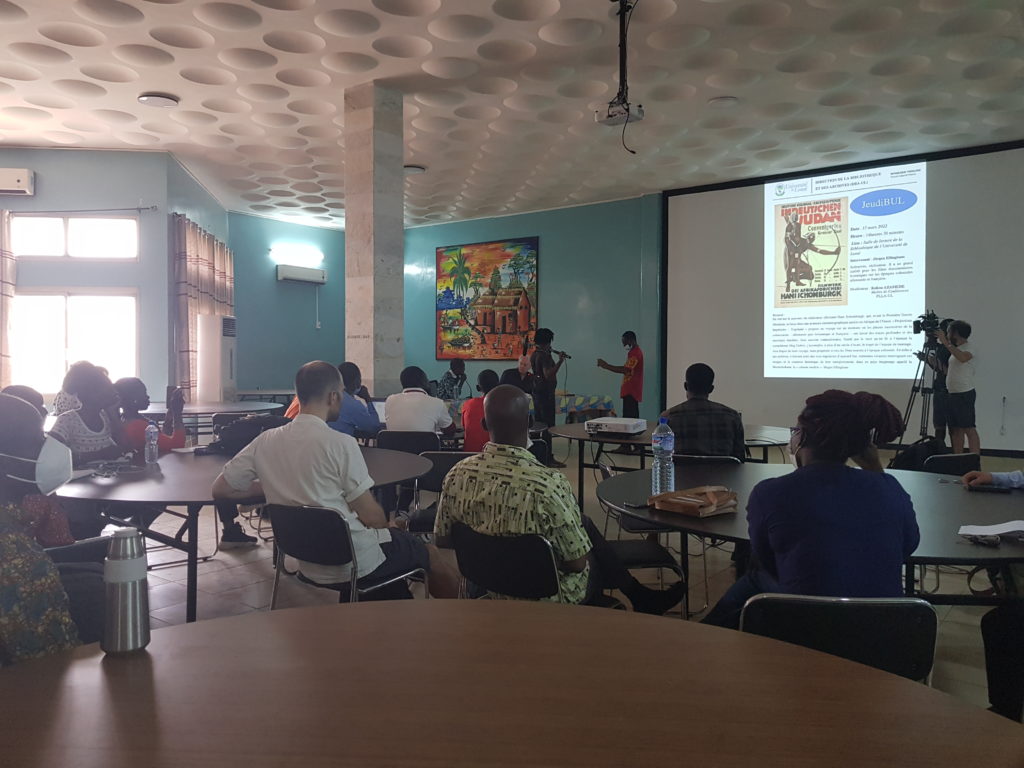To go to Togo
Seated behind a concrete table a conscientious student who wants to migrate to Germany asks his colleague, as she looks at her notes: »Was isst du für Frühstuck?«. Every day I watched these two German language students studying, conversing, and writing their homework from the concrete benches in front of the Faculty of Germanic Languages at the University of Lomé. There I have been waiting to meet my host and English language students who were helping me with a month-long field research in Togo, part of which focused on the Slovenian influences on the German colonial legacy. During my fieldwork there, the fraught and complex relationship with the colonizers came to the fore: what is the relationship of Togolese people to Germany (and France) today, and in what ways can we understand difficult heritage in Togo and its relationship to the German colonial past?

On my first day there student Razak showed me sights of the capital Lomé on his motorbike: we started at Independence Square[1], encircled by a roundabout. In immediate vicinity stands the National Museum, unknown to many locals: “I haven’t visited it, we are familiar with what’s in it anyway,” (Reberc 2022) Razak replied puzzled by the question, a comment later confirmed by others. During my visit to this modest museum consisting of two rooms (a larger ethnographic room and a smaller basement history room) the museum’s curator, historian, confirms, that many ethnographic objects are still in use today. No direct traces of the colonial past are presented, with an exception of the historical section that highlights the protectorate charter, portraits of German and French colonizers, and a worn-out wooden map with towns and main routes marked on it. The student and I drove around the square and finally to the beach, where one of the few tangible remnants of the colonial legacy can be found: a dilapidated pier used by the Germans to export raw materials from the Togoland Protectorate to Germany. On the other side of the road, a faded information board in three languages (French, German, Ewe) gives a glimpse of the purpose and circumstances of the marine ruins.

The railway, a key infrastructure that allowed raw materials from different parts of the city to reach the port, goes almost unnoticed. During German colonial rule, three key railways were built: from south-eastern Anecho (the former capital at the start of the protectorate) for the transport of coconut, from south-western Kpalimé for the transport of cocoa, and northern Agbonou for the transport of cotton. “Today there are no trains, only a short railway to transport concrete. I still remember trains from when I was little, but now they are long gone,” (Reberc 2022) my host commented, looking at the infrastructure that still existed: overgrown and littered tracks, warning signs, saltires, and ramps pushed to the side. Many roads cross the tracks and draw the attention of drivers with vibrations, while others follow the main road out of the capital and sometimes appear from the overgrown bank. “Traces were left behind. Like railways, roads, it was them [the Germans, ed. Ana Reberc] who built the tracks,” (Reberc 2022) commented a cotton producer from the central part of the country. Most people are not concerned by these permanent and visible spatial elements. Nor do they seem to be bothered by the uselessness of the railway, due to which all commercial traffic runs on the only two-lane road from south to north. It is quite common for cars to overtake numerous trucks in long lines, blocking traffic in the opposite lane and creating traffic jams.

Recently renovated Governor’s Palace in Lomé (destroyed in the protests of the early 1990s), which served both the German and French authorities and then housed various institutions of the Togolese state, is in much better shape. After its renovation, it was designed as a modern cultural and arts centre,[2] though currently – like its website – not accessible to the public. Contrary to that is the cathedral, located in the middle of the main market, prominently overlooking the densely packed stalls crowded with people. Seemingly the most neglected element are the ruins of the foundations of the telecommunication station. Located in Kamina, a town in the central part of the country near Atakpamé, it was built to establish a direct link with Berlin[3] Supervision of its construction was entrusted to baron Anton Codelli, an Austro-Hungarian engineer of Italian heritage living in Ljubljana. In his castle at Kodeljevo, we can treat ourselves to family-sized pizza and admire a commemorative plaque in his honour. Kamina is one of the sites – besides the pier, the cathedral, and the palace – that Togolese pupils have to memorize in their history classes about German colonialism, yet it is hard to learn more about it, especially about non-thematized Slovenian involvement. However, several interlocutors mentioned that the ministry of culture is working on a project that would at least provide information boards in the town. German colonial past is clearly visible in the built heritage that accentuates it, nevertheless, during my short fieldwork, another aspect came to the fore. A certain mentality was identified in the conversations during my short stay: a positive evaluation of German colonization.
I realized that I had no insight into the French heritage in Togo only after going through the gathered materials. Not only had I deliberately focused on the German Togoland period (territory that is today divided between Togo and Ghana), but also the interlocutors and guides haven’t mentioned the French colonization period apart from contempt and never emphasized the heritage of this period. Most people however use French daily to keep in touch with francophone countries in Africa online, through music and daily encounters, as well as with France that still retains strong economic and political influence in the country.[4] The combination of resentment and resistance to the continuous French presence, efforts to unify the Togoland territory, and the long-standing political consensus of the friendship between the Togolese government and Germany have encouraged and sustained germanophilia in Togo (Yigbe 2017). Historical narratives of Togolese-German ties and reinforcements of the positive connotations of German colonization (Yigbe 2017) have been detected in everyday life. German colonisation period is accompanied by a great deal of pride. “My father told me that they were proud when Germans were here because at least they built a lot of roads, they built railways […] They were more proud in the German period than in the French one,” (Reberc 2022) said a farmer I interviewed. The comparison between German and French colonisation occurred without elicitation, the first perceived as the lesser of two evils or with a positive influence on Togo (Lippelt 2020). The pro-German sentiment is still prevalent: the high school study material on German colonization describes the administrative structure and highlights the development of agronomy, industry, transport, commerce, health, and education. The conclusion is written as follows: ‘Despite the brutality of their administration, Germans left an extensive legacy in Togo. Many of their interventions still exist today. This is why the Togolese remember German colonisation with nostalgia.”[5] When exploitative aspects are mentioned today if at all, they are subordinated to a positive evaluation of the German presence through a narrative of utility. What remained are the long-lived, still useful institutional and material aspects introduced under German rule (ibid.). The combination of narratives of comparison and utility also expresses itself as the unfulfilled potential of Togo, development brought to a halt by the replacement of the colonialists (ibid.), or, as seen in a casual remark by a student: “If we had stayed under the Germans, other African countries would envy us,” (Reberc 2022).

On a guided tour of the Togo-Ville (a village near which the protectorate charter was officially signed) the group, consisting of a Chilean (from German), an Italian (from Burkina Faso), a Belgian (living between Belgium and Senegal) and a Slovene (Reberc 2022), stopped in front of the monument of German-Togolese friendship. A holiday with the same name is celebrated there every year on 5 July, but there are no German representatives at this event, nor is there any cooperation between Germany and the village facilitating friendship nowadays. The overall picture is quite different – cooperation between Germany and Togo is currently very active (Yigbe, 2017). Cultural institutions such as the Goethe Institute are active in Togo, many are learning German in search of a better future outside their country with aspirations of finding work in Germany. Positive connotations are also encouraged through absent reminders of the past exploitation and the civilizing narratives of colonial empires (Lippelt 2020), clearly conveyed also by the Togolese political elite (see Yigbe 2017). “The colonizers never speak of their own brutality. They give the impression that colonisation is easy and that the people have accepted it. The only advantage was firearms. People who resisted were brutally conquered with firearms,” (Reberc 2022) commented an interlocutor from a local NGO.

An important, but generally unknown source that vividly illustrates the exploitation of the local population during German colonisation is the ethnographic movie In the German Sudan (Im deutschen Sudan, 1913/1917). Coincidentally the colonial domination was documented by the German director Hans Schomburgk at the exact time of Codelli’s construction of the Kamina station. Thus, the everyday life, hard work of the locals throughout the building process, as well as Codelli himself, are preserved in a digitised version of the aforementioned film. An even bigger coincidence was that at the time of my visit, the contemporary German director Jürgen Ellinghaus was showing clips of the film in different places around the country and in the Lomé University Library (Reberc 2022). During the screening, Ellinghaus pointed out that the film is largely fictional, but it is nevertheless a rare document of the time. Dr. Kokou Azamede, professor of German language and colonial history, added: “The work done is not fiction”. Ellinghaus explained that: “They worked to pay off debts, taxes for colonisation [of the German protectorate].” Footage of rail making process, visible risks, and carrying of heavy loads accompanied with a simultaneous narration of Ellinghaus and Azamede, evoked headshakes, uneasiness, and, in the most dramatic shots, noise in the audience that drowned out the descriptions. “Seeing these pictures and reading about colonial history are two different things. Nowhere does it say that the Togolese did this kind of work. It was a job done with all the risk on the part of the Togolese. They are the victims. What is the price of those who died [in the process]?” the student reflected during the screening. The director added that the film of course conceals the injuries and deaths due to mistreatment, illness, working accidents, and lack of medical care. “On the one side well-dressed white people and the other side naked black people. We see colonialism in this situation, leftover heritage. It was not white people who made this, but black workers. We do not have documentaries like this one to show our people what our history is,” another student says. We watch the movie in horror, together with students, depicting the exploitation of locals during the construction of a remarkable structure. It was demolished with explosives at the outbreak of the Great War following orders of the engineer, who returned to Ljubljana enriched with many items for his African room.
The dialectical relationship between the brutal exploitation and subjugation of the population on the one hand, and the emphasis and celebration of German-Togolese friendship on the other, creates a complex narrative about remembering, experiencing, and accepting the past. “If I were in that situation [as the workers in the documentary, ed. Ana Reberc], I would have pushed the white man into the water when we would have crossed the bridge,” comments one of my student interpreters. The one who should be pushed into the water today escapes his view and only sometimes appears to him in the form of a hated France.
References
- Lippelt, J. (2020). Narratives of collective memory: The memory of German colonization in Togo. Master’s thesis. Brandenburgische Technische Universität Cottbus-Senftenberg.
- Reberc, A. (March, 2022). Fieldwork notes.
- Schomburgk, H. (1913/1917). Im deutschen Sudan. Ethnographic movie.
- Yigbe, D. (2017). Is Togo a Permanent Model Colony? In K. Mühlhahn (ed.), The cultural legacy of German colonial rule (str. 97–112). De Gruyter.
footnotes
- Republic of Togo gained independence on 27. 4. 1960.[↑]
- https://worldarchitecture.org/article-links/evchn/the-palais-de-lom-a-journey-to-the-heart-of-the-natural-and-cultural-diversity-of-west-africa.html[↑]
- Another telecommunication station was located in Togblékopé and connected Togoland with the German Base in Cameroon. (Handouts from the highschool history class).[↑]
- https://www.diplomatie.gouv.fr/en/country-files/togo/[↑]
- Handouts from the highschool history class.[↑]
